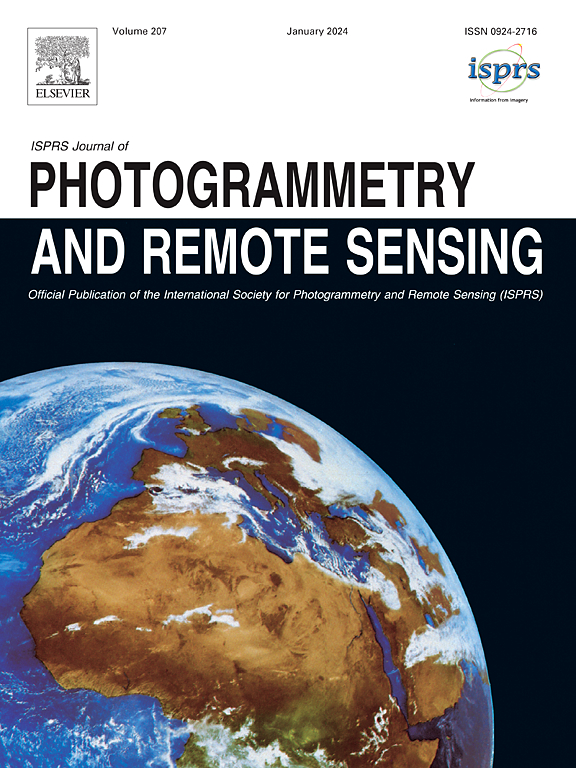从哨兵-2 图像直接绘制潮滩稳健地图的高效指数
IF 10.6
1区 地球科学
Q1 GEOGRAPHY, PHYSICAL
ISPRS Journal of Photogrammetry and Remote Sensing
Pub Date : 2024-10-12
DOI:10.1016/j.isprsjprs.2024.10.005
引用次数: 0
摘要
作为潮间带的重要组成部分,滩涂(TFs)资源丰富,物质和能量交换最为频繁。然而,由于人类活动和极端气候条件的双重威胁,潮滩正在大规模消失。尽管潮汐区十分重要,但由于其复杂多变的性质,准确绘制潮汐区地图仍具有挑战性。然而,潮汐影响极大地增强了 TFs 的多样性和变异性,悬浮颗粒带来的浑浊度挑战了用于区分水域和陆地的传统指数。本研究的重点是位于江苏中部沿海的世界上最大的潮间带沉积系统,该地区具有复杂的沉积特征和动态 TF 条件。通过定量分析潮间带在不同年份、季节和潮汐阶段的光谱特征,本研究发现了潮间带的两个独特光谱特征:均匀的低反射率值和梯形光谱形状。利用梯形光谱形状中的低反射率、中间段的平坦性以及各临界波段的先增后减趋势,开发了一种新的潮汐平坦指数(TFI)。实验结果表明,TFI 适用于跨年、跨季和跨潮汐阶段的稳健而直接的 TF 映射,在 12 种不同情况下的 F1 分数均超过 0.95。与其他指数和基于规则的方法相比,TFI 具有更高的准确性、阈值稳定性、背景和云抑制能力。该研究还扩展到其他全球丰富的 TFs 区域,以证明所提出的指数在各种环境中的普遍性和适用性,包括其在划分年度 TFs 范围方面的有效性。这项研究为基于单幅哨兵-2 多光谱图像自动绘制 TFs 地图提供了技术支持。本文章由计算机程序翻译,如有差异,请以英文原文为准。
A highly efficient index for robust mapping of tidal flats from sentinel-2 images directly
As an essential component of the intertidal zone, tidal flats (TFs) are areas rich in resources where with the most intense material and energy exchanges. However, due to the dual threats of human activities and extreme climate conditions, TFs are disappearing on a large scale. Despite their importance, accurately mapping TFs has proved challenging due to their complex and dynamic nature. Nevertheless, Tidal influences significantly enhance the diversity and variability of TFs, and suspended particulates introduce turbidity that challenges conventional indices used for distinguishing between water and land. This study focuses on the world’s largest intertidal sedimentary system located along the central coast of Jiangsu, an area characterized by complex sedimentary features and dynamic TF conditions. Through quantitative analysis of the spectral characteristics of TFs at different years, seasons, and tidal stages, this study identifies two unique spectral features of TFs: uniformly low reflectance values and a trapezoidal spectral shape. Leveraging the low reflectance, the flatness of the middle segment in the trapezoidal spectral shape, and the initial increase followed by a decreasing trend across critical bands, a novel Tidal Flat Index (TFI) has been developed. Experimental results indicate that TFI is suitable for robust and direct TF mapping across years, seasons, and tidal stages, achieving F1 scores exceeding 0.95 in 12 different scenarios. Compared to other indices and rule-based methods, TFI offers greater accuracy, threshold stability, background and cloud suppression. The study also extends to other globally rich TFs regions to demonstrate the universality and applicability of the proposed index in various environments, including its effectiveness in delineating annual TFs extents. This study offers technical support for the automatic mapping of TFs based on single Sentinel-2 multispectral images.
求助全文
通过发布文献求助,成功后即可免费获取论文全文。
去求助
来源期刊

ISPRS Journal of Photogrammetry and Remote Sensing
工程技术-成像科学与照相技术
CiteScore
21.00
自引率
6.30%
发文量
273
审稿时长
40 days
期刊介绍:
The ISPRS Journal of Photogrammetry and Remote Sensing (P&RS) serves as the official journal of the International Society for Photogrammetry and Remote Sensing (ISPRS). It acts as a platform for scientists and professionals worldwide who are involved in various disciplines that utilize photogrammetry, remote sensing, spatial information systems, computer vision, and related fields. The journal aims to facilitate communication and dissemination of advancements in these disciplines, while also acting as a comprehensive source of reference and archive.
P&RS endeavors to publish high-quality, peer-reviewed research papers that are preferably original and have not been published before. These papers can cover scientific/research, technological development, or application/practical aspects. Additionally, the journal welcomes papers that are based on presentations from ISPRS meetings, as long as they are considered significant contributions to the aforementioned fields.
In particular, P&RS encourages the submission of papers that are of broad scientific interest, showcase innovative applications (especially in emerging fields), have an interdisciplinary focus, discuss topics that have received limited attention in P&RS or related journals, or explore new directions in scientific or professional realms. It is preferred that theoretical papers include practical applications, while papers focusing on systems and applications should include a theoretical background.
 求助内容:
求助内容: 应助结果提醒方式:
应助结果提醒方式:


